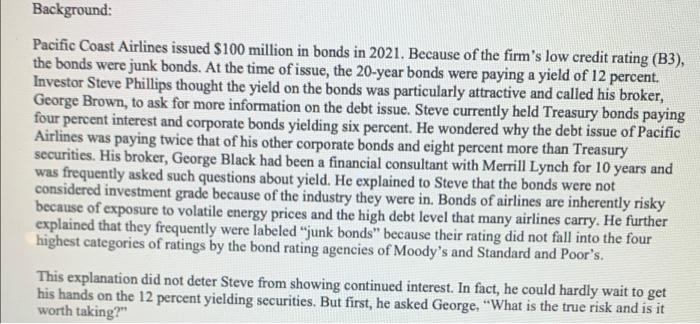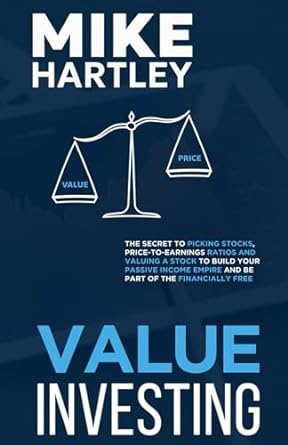Background: Pacific Coast Airlines issued $100 million in bonds in 2021. Because of the firm's low credit rating (B3), the bonds were junk bonds. At the time of issue, the 20-year bonds were paying a yield of 12 percent. Investor Steve Phillips thought the yield on the bonds was particularly attractive and called his broker, George Brown, to ask for more information on the debt issue. Steve currently held Treasury bonds paying four percent interest and corporate bonds yielding six percent. He wondered why the debt issue of Pacific Airlines was paying twice that of his other corporate bonds and eight percent more than Treasury securities. His broker, George Black had been a financial consultant with Merrill Lynch for 10 years and was frequently asked such questions about yield. He explained to Steve that the bonds were not considered investment grade because of the industry they were in. Bonds of airlines are inherently risky because of exposure to volatile energy prices and the high debt level that many airlines carry. He further explained that they frequently were labeled "junk bonds" because their rating did not fall into the four highest categories of ratings by the bond rating agencies of Moody's and Standard and Poor's. This explanation did not deter Steve from showing continued interest. In fact, he could hardly wait to get his hands on the 12 percent yielding securities. But first, he asked George, "What is the true risk and is it worth taking?" 1. Answer Steve's question. What is the true risk and is it worth taking? Consider the economy and the industry of PCA (The answer to this question should be at least 150 words in length. No direct quotes.) 2. If the yield in the market for bonds of this nature were to go up to 15 percent due to poor economic conditions, what would the new price of the bonds be? They have an initial par value of $1,000. Assume two years have passed and there are 18 years remaining on the life of the bonds. Use annual analysis. 3. Compare the decline in value to the eight percent initial interest advantage over Treasury bonds (12 percent versus four percent) for this two-year holding period. Base your analysis on a $1,000 bond. Disregarding tax considerations, would Steve come out ahead or behind in buying the high yield bonds? 4. Recompute the price of the bonds if interest rates went up by only one percent to 13 percent with 18 years remaining. Why does the 8 percent interest rate advantage over the two-year holding period cover the loss in value? (Response should be at least 100 words, no direct quotes). 5. Now assume that economic conditions improve and the yield on similar securities goes down by 2 or 3 percent over the two years. How does Steve come out? Discuss the answer. No calculation is necessary. If Steve holds the bonds to maturity and there is no default), does the change in the required yield in the market over the life of the bond have any direct effect on the investment? (Response should be at least 100 words, no direct quotes). Background: Pacific Coast Airlines issued $100 million in bonds in 2021. Because of the firm's low credit rating (B3), the bonds were junk bonds. At the time of issue, the 20-year bonds were paying a yield of 12 percent. Investor Steve Phillips thought the yield on the bonds was particularly attractive and called his broker, George Brown, to ask for more information on the debt issue. Steve currently held Treasury bonds paying four percent interest and corporate bonds yielding six percent. He wondered why the debt issue of Pacific Airlines was paying twice that of his other corporate bonds and eight percent more than Treasury securities. His broker, George Black had been a financial consultant with Merrill Lynch for 10 years and was frequently asked such questions about yield. He explained to Steve that the bonds were not considered investment grade because of the industry they were in. Bonds of airlines are inherently risky because of exposure to volatile energy prices and the high debt level that many airlines carry. He further explained that they frequently were labeled "junk bonds" because their rating did not fall into the four highest categories of ratings by the bond rating agencies of Moody's and Standard and Poor's. This explanation did not deter Steve from showing continued interest. In fact, he could hardly wait to get his hands on the 12 percent yielding securities. But first, he asked George, "What is the true risk and is it worth taking?" 1. Answer Steve's question. What is the true risk and is it worth taking? Consider the economy and the industry of PCA (The answer to this question should be at least 150 words in length. No direct quotes.) 2. If the yield in the market for bonds of this nature were to go up to 15 percent due to poor economic conditions, what would the new price of the bonds be? They have an initial par value of $1,000. Assume two years have passed and there are 18 years remaining on the life of the bonds. Use annual analysis. 3. Compare the decline in value to the eight percent initial interest advantage over Treasury bonds (12 percent versus four percent) for this two-year holding period. Base your analysis on a $1,000 bond. Disregarding tax considerations, would Steve come out ahead or behind in buying the high yield bonds? 4. Recompute the price of the bonds if interest rates went up by only one percent to 13 percent with 18 years remaining. Why does the 8 percent interest rate advantage over the two-year holding period cover the loss in value? (Response should be at least 100 words, no direct quotes). 5. Now assume that economic conditions improve and the yield on similar securities goes down by 2 or 3 percent over the two years. How does Steve come out? Discuss the answer. No calculation is necessary. If Steve holds the bonds to maturity and there is no default), does the change in the required yield in the market over the life of the bond have any direct effect on the investment? (Response should be at least 100 words, no direct quotes)









